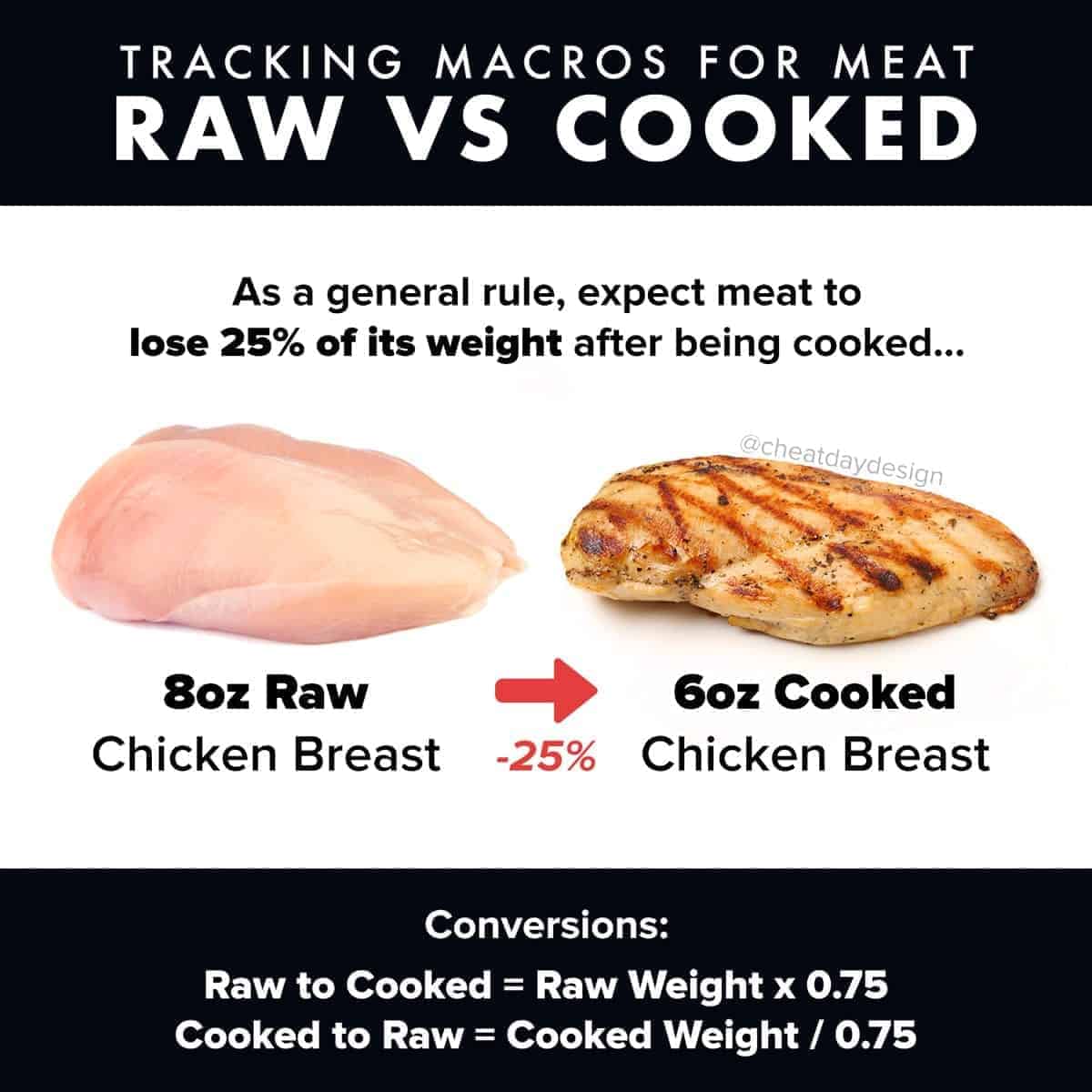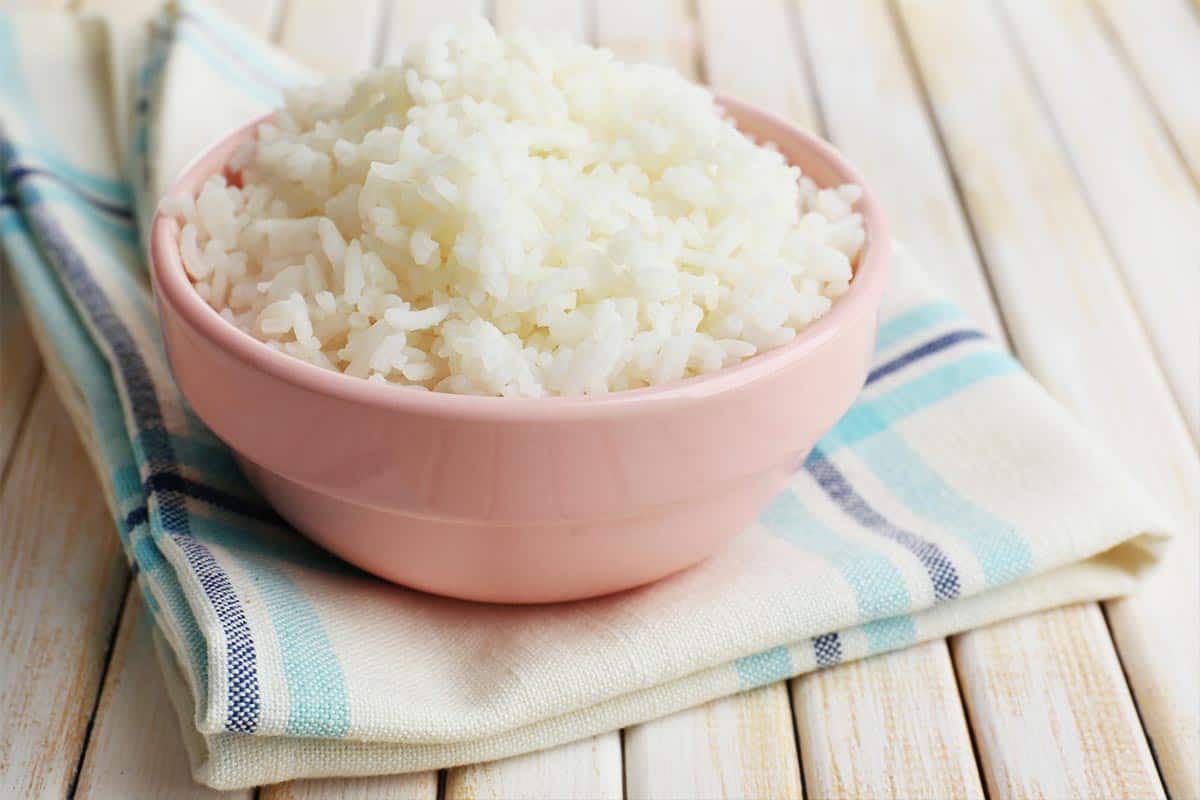How much cooked, deboned chicken do you need for a recipe? Use these helpful hints to make sure you don’t buy too little or too much chicken.
1 pound of raw chicken equals roughly 1 cup of cooked, deboned chicken when using a whole chicken. A 2 12 to 3 pound whole chicken, or fryer, will, for instance, yield approximately 2 to 3 cups of cooked, cubed chicken.
Additionally, you can buy a rotisserie chicken to add to your recipe. The average rotisserie chicken is about 2 pounds. About 3 cups of chicken will be produced from a whole chicken, with approximately 2 cups of white meat and 1 cup of dark meat. White meat comes from the chicken breast and wings. Dark meat comes from the thighs and drumsticks.
Nutrition labels always display information based on raw weight

Unless otherwise stated, the nutrition information for your food will always be based on its raw weight.
Most bacon packages list “2 pan-fried strips” as the serving size, which denotes cooked bacon. Otherwise, it presumes that the food is raw if it doesn’t specify.
Let’s look at ground beef as an example.
4 ounces of raw ground beef constitute one serving of 4 ounces of ground beef.
The 4 ounces of ground beef will be reduced to about 3 ounces when cooked.
The nutrition label indicates that the 3 ounces of cooked meat should be tracked as 4 ounces of raw meat.
How is it that 4 ounces of uncooked meat has more nutritional value than 3 ounces of cooked meat?
The only thing changing here is water weight. When the meat cooks, it loses water. Nothing else is changing!.
I want to reiterate this because this is where people get confused.
Meat weighs less but still has the same nutritional value.
Do calories or macros change when you cook food?
The calories in your food remain the same whether you weigh it raw or cooked.
This throws a lot of people off. How is it that 4 ounces of cooked rice has more calories than 2 ounces of raw rice?
Isn’t it double the amount?
Not exactly.
Using rice as an example, all you do when you cook it is boil it in water. The serving doubles in size as a result of the rice absorbing the water.
The volume of the food has not changed, even though the weight has doubled. You have the same exact amount of rice!.
A serving size of 4 ounces of cooked rice contains exactly the same number of calories as 2 ounces of uncooked rice.
Raw to cooked conversions for various foods
![]()
You probably want to know how to convert from raw to cooked weight, or vice versa, if you’re reading this.
Since each food conversion is unique and there are numerous factors to consider, no conversion will ever be 100% accurate. Before we get into the actual conversions, keep in mind that the weight can vary depending on a number of factors:
Raw vs cooked meat weight conversion

Raw to cooked meat conversion: Raw weight x 0. 75 (example: 4oz raw x 0. 75 = 3oz cooked).
Cooked to raw meat conversion: Cooked weight / 0. 75 (example: 8oz cooked / 0. 75 = 8oz raw).
Regardless of the type of meat you use, you can safely assume that it will lose about 25% of its weight during the cooking process.
I have personally used chicken breast to test this a few times, and I can attest that it is quite accurate. It will almost always cook down from 8 ounces of uncooked chicken to 6 ounces of cooked chicken when comparing cooked vs. uncooked chicken.
The nutrition information on a package of meat is based on the weight of the raw meat.
I advise weighing the raw meat before cooking for convenience and to eliminate any uncertainty. During the cooking process, you’ll probably add seasonings, sauces, or marinades, which could change the final weight.
However, there will undoubtedly be instances where you can only weigh your cooked meat, particularly if someone else is doing the cooking. In those circumstances, this conversion will be useful.
You can divide an 8-ounce serving of cooked chicken by 0 if you find yourself in that situation. 75, you’ll discover that the nutrition is equivalent to about 11 ounces of raw chicken. Even though it won’t be exact, that will be a very close estimate.
Uncooked vs cooked pasta weight conversion

Raw to cooked pasta conversion: Raw weight x 2. 25 (example: 2oz raw x 2. 25 = 4. 5oz cooked).
Cooked to raw pasta conversion: Cooked weight / 2. 25 (example: 8oz cooked / 2. 25 = roughly 3. 5oz raw).
We’ve talked a lot about how cooking causes meat to lose water weight, which results in weight loss.
Pasta tells a different story. When you cook pasta, it actually GAINS weight.
The typical serving size for pasta on the nutrition label is 2 ounces. That is 2 ounces of uncooked pasta.
You would be extremely disappointed if you portioned out 2 ounces of cooked pasta for yourself to discover that it is TINY. Instead, you need to weigh out 4. 5 ounces of the cooked pasta.
Prior to adding any type of sauce, weigh your pasta if you’re keeping track of it.
The sauce will inevitably add some extra weight, which will affect your conversion.
Uncooked vs cooked brown rice weight conversion

Converting raw weight to cooked weight for brown rice is as follows: (2 oz. raw x 2) = 4 oz. cooked.
Brown rice conversion from cooked to raw: Cooked weight / 2 (8 oz cooked / 2 = roughly 4 oz uncooked).
When cooked, brown rice will gain weight similarly to pasta. Your rice will typically double in weight when it is cooked.
Once it has been cooked, rice is one of those foods that many people find themselves weighing. For instance, if you order Chinese food to go, you’ll receive a pint of rice. These conversions are useful for determining how much to measure out for a serving.
You can choose the serving size, but whatever you weigh out, keep in mind that the uncooked weight is half of what you are weighing.
If you are trying to track your nutrition and portion out 6 ounces of cooked brown rice, it will have the same nutritional value as 3 ounces of uncooked brown rice.
Uncooked vs cooked white rice weight conversion

Converting raw weight to cooked weight for white rice is as follows: 2 oz raw times 3 equals 6 oz cooked.
White rice can be converted from cooked to raw by multiplying the cooked weight by three (for instance, 3 oz cooked divided by three equals 2 oz uncooked).
When cooked, white rice typically triples in size and behaves somewhat differently from brown rice.
White rice is always my go-to when I order takeout. If you have cooked white rice and want to calculate the nutrition, you must divide the weight by 3.
Divided by three, 6 ounces of cooked white rice provides the same amount of nutrition as 2 ounces of uncooked white rice.
Should you track the raw or cooked weight of food?
It can be challenging to determine how to precisely weigh your portions if you’re tracking your macros (or just your calories).
If you can avoid it, my advice is to always weigh your food when it is still raw. The labels are always based on raw weight, so it makes your life the easiest, eliminates any uncertainty and confusion, and it’s consistent every time.
Before cooking anything, whether it be meat, potatoes, pasta, or rice, it is very beneficial to weigh it out. You don’t even need to weigh the rice out at the end if you know that cooking 4 oz of rice will yield two 2 oz servings.
To me, that’s always the easiest way to go.
I always cut the meat into exactly the right portion sizes for me. I’ll cut the raw chicken breast into the desired 8 oz portion when it comes to chicken breast. When it’s cooked, the weight doesn’t matter because we know it will shrink to 6 ounces, and we can then experiment with marinades, sauces, and spices without worrying about it.
Having said that, I completely appreciate that sometimes you can’t weigh your food before it’s prepared. You might not have the choice to weigh your food raw if you’re eating takeout or a dish that someone else made.
These conversions will help you get very close, even though they might not be 100% accurate, in that situation.
We don’t need perfection when it comes to tracking macros; we just want to be close.
And if you want to figure out your own caloric or macronutrient requirements, use my free Calorie & Macro Calculator, which will not only give you numbers but also explain why I suggest the things I do to make things as simple as possible for you.
FAQ
How do you convert raw cooked chicken?
You can divide an 8-ounce serving of cooked chicken by 0 if you find yourself in that situation. 75, you’ll discover that the nutrition is equivalent to about 11 ounces of raw chicken.
Is 4 oz of raw chicken the same as cooked?
Here is a general guide to converting portions of meat and poultry from raw to cooked: According to Dubost, it’s reasonable to assume that cooking will cause you to lose about a quarter of the weight of meats. Therefore, four ounces of boneless, raw meat will yield about three ounces of cooked meat.
How many cups of cooked chicken breast are in a pound?
Generally speaking, 3 cups of chicken are equal to 1 pound of boneless, skinless chicken breasts. Given that a serving of chicken is typically 3/4 cup per person, that yields approximately 4 servings.
Should I weigh my chicken breast Raw or cooked?
The most accurate way to measure your food is when it’s raw because when you cook anything, either it absorbs water or it evaporates. For instance, cooked chicken weighing 100 grams will be less than uncooked chicken. The time and method of cooking will determine the weight change.
